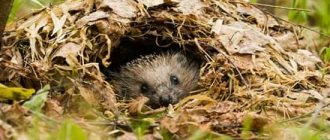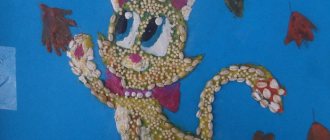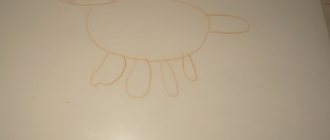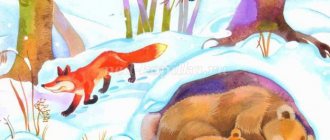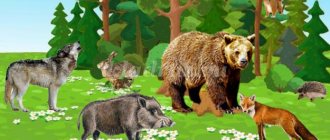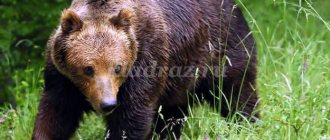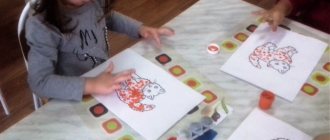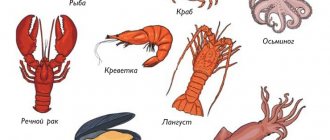Animals begin to prepare for winter during the warm season.
In the fall, squirrels can be seen carrying nuts into their hollows or burying them in the ground, only to dig them up a few months later for a winter snack.
Mice and beavers bring extra food into their homes to have food when it gets too cold, and bees store honey all summer and fall. Most mammals eat extra fat during the warm months to last through the winter. It will not only warm them during the cold season, but will also not leave them hungry.
Other animals adapt to winter weather by changing their appearance. The fur becomes thicker and heavier just as we change from an autumn jacket to a winter one. Animals such as the rabbit and the Arctic fox completely change the color of their fur, going from dark colors in summer to white in winter. This property sometimes saves their lives, because... allows them to better camouflage in the snow, making them more invisible.
Some animals are preparing for winter hibernation. For example, bears, skunks, and hedgehogs prepare cozy dens and sleep almost all winter. They enter a state of torpor, which transitions into a state of reduced physiological activity, allowing them to reduce their body temperature and metabolic rate. This allows them to survive without much food. Others, such as chipmunks, marmots, bats and even snakes, fall into an even deeper sleep, where their bodies become still for months, often not waking up until spring. This allows animals to save energy and not have to worry about food and cold for a while. They wake up hungry and often unhappy, but at least they were able to escape the worst of the weather.
Some creatures don't want to deal with winter at all! Instead, they move to places where they can easily find food and not freeze from the cold. This is called migration. Caribou and some species of deer make winter treks, as do whales and some fish, which swim long distances in search of warmer water. Even monarch butterflies fly from Canada and the United States to Mexico in search of sunnier days. In the spring, migration occurs in the opposite direction, to where winter has finally ended.
Let's look at preparing some animals for winter in more detail.
Who is first?
Nature has created separate “schedules” for various animals to organize for the winter.
Some forest dwellers begin to prudently think about cold weather not in late or early autumn (like other animals). They carry out procurement work already in the summer.
In what order do different mammals come up with the idea of preparatory activities? Rodents - wood mice, chipmunks and gophers - think about winter before others. And also boibaks (inhabitants of the “borderland” of the green area - the so-called forest-steppe). After them, fellow hamsters come into play, carrying tasty reserves in their mouths from September 1st. Squirrels (part of the same zoological community) act only at the height of Pushkin's time.
The next category of inhabitants of fragrant green thickets is the hedgehog family. They also don’t wait until the 12th month, trying to finish the important matters mentioned already in the 10th or 11th.
Only after the rest of the inhabitants of the dense tree stand do predators and the hare remember the upcoming frost and the accompanying hunger. Some are not going to work at all in winter. Better sleep.
Let's talk about how animals prepare for winter, revealing the nuances of the work of 4 zoo families.
Wild animals are preparing for winter. Brown bear
Not far from the forest dormice, the clubfooted ones also left. In particular, the owner of the Russian taiga is the brown bear. Bears are predatory animals that do not make any storehouses for themselves, preferring to hibernate for the winter. Speaking in metaphorical terms, clubfooted heavyweights are their own “storerooms”, because all summer and all autumn they try to eat large reserves of subcutaneous fat in their bodies. Moreover, fat is an excellent “insulation” in the winter!
Clubfoots begin to get fat when the berries ripen in the forest. While animals prepare for winter in one way or another, bears diligently feed on plant rhizomes, berries, nuts, etc. The brown bear's favorite delicacy is honey. For the sake of its sweet and alluring taste, the beast is ready to endure the stings of angry wild bees for hours. But the bear’s “menu,” of course, is not limited to plant foods. Do not forget that this animal is a real predator, therefore, along with berries and nuts, these animals feed on young deer, hares, foxes, wolves and fish. It doesn't cost a bear anything to kill an adult moose!
But gaining subcutaneous fat is only half the battle. Before the onset of prolonged cold weather, the clubfoot must have time to find a secluded place for its future den. Bears do this with enviable care. As soon as the place is found, the animal begins “construction”: it digs a hole in the ground, insulating it with branches, moss, pine needles and other available materials. If the search for a place for a den in a particular forest is unsuccessful, the bear may covet someone else’s shelter. Some of them even drive the current guest out of there and lie there themselves. This is what it is like – a bear’s preparation for winter!
How squirrels and beavers prepare for winter
Squirrels live in hollows - deep voids located in tree trunks. And at a high altitude. For protection from arrogant predators. Amazingly agile owners of ears with tassels put nuts and other delicacies that they love so much there. Acorns, mushrooms and a variety of seeds are also good for nutrition.
Among the toothy ones, God awarded the beavers with the most powerful oral incisors. And so they quickly and skillfully build housing (it is always on the water - the forest itself floats into their teeth). And beavers live in large families. Therefore, they are able to build both a classic (summer) hut and winter (insulated) “apartments”. The food warehouse in the “January towns” is a pile of small branches and roots of aquatic flora. It remains to add that the dams are thoroughly strengthened closer to frost. Repairs are underway.
What is it and why do they fall into it?
Hibernation is the body’s reaction to temperature changes; in other words, it is a method of survival characterized by a decrease in body temperature and a reduction in heart rate.
Sonya the Regiment
In preparation for sleep, animals store up fat and prepare a shelter that is well protected from predators. During hibernation, an animal's body temperature can drop 10 times its normal temperature. So, for example, the temperature of a dormouse (a small rodent) drops from 38 degrees to 3.7. The heart slows down to 3 – 5 beats per minute, and in California ground squirrels it can even drop to one beat. Breathing decreases 10 times. In general, all body activity is reduced to a minimum.
Interesting: Why does a chameleon change color?
Preparing hedgehogs
Animals can carry supplies for the winter directly on their backs (without using their limbs, but using needles). And the conversation, as you guessed, is about hedgehogs. Seeing “fallen” apples and high-calorie “forest meat” (mushrooms), these cunning creatures turn into a particularly prickly ball and roll over their finds. They literally pin them on their backs.
But it’s not only the food listed that hardworking hedgehogs bring to their winter nests. In the cold, they are not averse to pampering themselves with fat caterpillars, suddenly numb (at the sight of a ball rolling on them) toads and mice. You just need to collect all this yummy stuff in the fall - before it’s under the ice.
Yes, yes - a harmless-looking hedgehog is actually a predator. Then, when he sees someone smaller. By the way, it eats snakes, worms and generally anything that crawls. Many died. Take it - I don’t want it.
But that's not all. The animal is so picky in terms of comfort that it also rebuilds its housing. In order not to tremble and toss and turn in the next 3 months. Insulates the ground nest with dry leaves, makes an orthopedic mattress useful for the spine - it carries pliable but elastic forest moss.
Stories, poems and educational tasks for children on the topic “How animals prepare for winter”
Hare.
Read to your child a fairy tale about a deciduous hare and how he encountered winter for the first time. From this fairy tale, the child will learn how different animals prepare for winter.
Skrebitsky G.A. Fairy tale "Everyone in his own way."
In the summer, in a clearing in the forest, a little hare was born to a long-eared hare. He was not born helpless, naked, like some little mice or squirrels, not at all. He was born with gray fluffy fur, with open eyes, so nimble, independent, he could immediately run and even hide from enemies in the thick grass.
“You’ve done well,” the hare told him in her hare language. - Lie here quietly under the bush, don’t run anywhere, and if you start running, jumping, traces of your paws will remain on the ground. If a fox or wolf stumbles upon them, they will immediately follow your trail and eat you. Well, be smart, rest, gain more strength, but I need to run and stretch my legs.
And the hare, making a big leap, galloped off into the forest. Since then, the little hare was fed not only by her own mother, but also by other bunnies, those who accidentally ran into this clearing. After all, hares have been like this since ancient times: if a hare comes across a baby, she doesn’t care whether it’s hers or someone else’s, she’ll definitely feed it milk.
Soon the little hare became completely stronger, grew up, began to eat lush grass and run through the forest, getting to know its inhabitants - birds and animals.
The days were fine, there was plenty of food around, and in the thick grass and bushes it was easy to hide from enemies.
The little hare lived for himself and did not grieve. So, without caring about anything, he lived through the warm summer.
* * *
But then autumn came. It's getting cold. The trees turned yellow. The wind tore withered leaves from the branches and circled over the forest. Then the leaves fell to the ground. They lay there restlessly: they fidgeted all the time, whispering to each other. And from this the forest was filled with an alarming rustle.
The little bunny could hardly sleep. Every minute he became wary, listening to suspicious sounds. It seemed to him that it was not the leaves rustling in the wind, but someone scary creeping up on him from behind the bushes.
Even during the day, the hare often jumped up, ran from place to place, and looked for more reliable shelters. I searched and didn’t find it.
But while running through the forest, he saw a lot of new and interesting things that he had never seen before in the summer. He noticed that all his forest acquaintances - animals and birds - were busy about something, doing something.
One day he met a squirrel, but it did not jump, as usual, from branch to branch, but descended to the ground, picked a boletus mushroom, then grabbed it tightly in its teeth and jumped up the tree with it. There the squirrel stuck a mushroom into a fork between the branches.
The little hare saw that several mushrooms were already hanging on the same tree.
- Why do you tear them and hang them on branches? - he asked.
- What do you mean why? - answered the squirrel. “Winter will come soon, everything will be covered with snow, then it will be difficult to get food.” So now I’m in a hurry to prepare more supplies. I dry mushrooms on branches, collect nuts and acorns in hollows. Don’t you store food for the winter yourself?
“No,” answered the bunny, “I don’t know how to do this.” Mother bunny didn't teach me.
“Your business is bad,” the squirrel shook her head. “Then at least insulate your nest better, plug all the cracks with moss.”
“Yes, I don’t even have a nest,” the bunny became embarrassed. “I sleep under a bush, wherever I have to.”
- Well, this is no good! — the farm squirrel spread its paws. “I don’t know how you will survive the winter without food supplies, without a warm nest.”
And she again began her chores, and the bunny sadly hopped on.
Evening had already come, the hare reached a remote ravine. There he stopped and listened carefully. Every now and then small lumps of earth rolled down the ravine with a slight noise.
The little bunny stood up on his hind legs to get a better look at what was going on there in front. Yes, this is a badger busy near the hole. The hare ran up to him and said hello.
“Hello, oblique,” answered the badger. - Are you still jumping? Well, sit down, sit down. Wow, I’m tired, even my paws hurt! Look how much earth I raked out of the hole.
- Why are you raking it out? - asked the bunny.
— For winter, I clean the hole so that it is more spacious. I’ll clean it out, then drag moss and fallen leaves there and make a bed. Then I won’t be afraid of winter either. Lie down and lie down.
“And the squirrel advised me to build a nest for winter,” said the hare.
“Don’t listen to her,” the badger waved his paw. “She learned to build nests in trees from birds.” A waste of time. Animals need to live in a hole. This is how I live. Help me better dig emergency exits from the hole. We’ll arrange everything as needed, climb into the hole, and spend the winter together.
“No, I don’t know how to dig a hole,” answered the bunny. “And I won’t be able to sit underground in a hole, I’ll suffocate there.” It's better to rest under a bush.
“The frost will soon show you how to rest under a bush!” the badger answered angrily. - Well, if you don’t want to help me, then run wherever you want. Don’t bother me with arranging my home.
The bunny ran further and ran out to the bank of a forest stream. He ran out and became wary.
Not far from the water, someone large and clumsy was fiddling around an aspen tree. “He’s the beaver,” he saw the stutterer and in two leaps found himself next to him.
- Hello, buddy, what are you doing here? - asked the bunny.
“Yes, I’m working, gnawing aspen,” the beaver answered slowly. I’ll throw it on the ground, then I’ll start biting off the branches, dragging it into the river, and insulating my hut for winter. You see, my house is on the island - it’s built all out of branches, and the cracks are coated with silt, inside I’m warm and cozy.
- How can I enter your house? - asked the Bunny. - The entrance is nowhere to be seen.
— The entrance to my hut is located below, under water. I will swim to the island, dive to the very bottom, and there I will find the entrance to my house. There is no better animal house than my hut. Let's insulate it together for winter, and let's spend the winter together.
“No,” answered the little hare, “I don’t know how to dive and swim under water, I’ll drown right away, I’d rather spend the winter under a bush.”
“You shouldn’t want to spend the winter with me,” the beaver answered and began gnawing on the aspen tree.
And the little hare hobbled further, away from the river, back into the forest.
Suddenly something rustles in the bushes! Kosoy was about to run away, but then an old acquaintance, a hedgehog, looked out from the fallen leaves.
- Great, buddy! - he shouted. - Why are you so sad, your ears hanging open?
“My friends upset me,” answered the bunny. “They say you need to build a warm nest or hut for the winter, but I don’t know how.”
— Build a hut? - the hedgehog laughed. - This is nonsense! You better do what I do: every night I eat more, store more fat, and when I have enough stored, then I will start to feel sleepy. Then I will climb into the fallen leaves, into the moss, curl up in a ball and fall asleep for the whole winter. And when you sleep, then neither frost nor wind are afraid of you.
“No,” answered the bunny, “I won’t be able to sleep all winter.” My sleep is sensitive, disturbing, I wake up every minute from every rustle.
“Well, then do as you please,” answered the hedgehog. - Goodbye, it’s time for me to look for a place for my winter sleep.
And the animal disappeared into the bushes again.
The little hare trudged further through the forest. Wandered, wandered. The night has already passed, the morning has come. He got out into the clearing. He looks - there are a lot of blackbirds gathered on it. All the trees are stuck around and are jumping around on the ground, screaming, chattering, arguing about something.
- What are you arguing about? - the little bunny asked the blackbird, who was sitting closer to him.
- Yes, we are discussing when we should fly from here to warm countries for the winter.
- Aren’t you going to stay in our forest for the winter?
- What are you, what are you! - the blackbird was surprised. - In winter, snow will fall and cover the entire ground and tree branches. Where can you get food then? We fly with us to the south, where it’s warm in winter and there’s plenty of food.
“Don’t you see, I don’t even have wings,” the hare answered sadly. “I’m an animal, not a bird.” Animals don't know how to fly.
“That’s not true,” the blackbird objected. - Bats are also animals, but they fly no worse than us birds. They have already flown south, to warm countries.
The little hare didn’t answer the blackbird, he just waved his paw and ran away.
“How am I going to spend the winter? - he thought anxiously. - All animals and birds prepare for winter in their own way. But I have neither a warm nest, nor food supplies, and I won’t be able to fly south. I’ll probably have to die of hunger and cold.”
* * *
Another month has passed. The bushes and trees have shed their last leaves. The time has come for rain and cold weather. The forest became gloomy and dull. Most of the birds flew to warm countries. The animals hid in holes, in nests, in lairs. The little bunny was not happy in the empty forest, and besides, something bad happened to him: the bunny suddenly noticed that his skin began to turn white. The summer gray wool was replaced by a new one - fluffy, warm, but completely white. First, the hind legs, sides, then the back and, finally, the head turned white. Only the tips of the ears remained black.
“How can I hide from my enemies now? - the hare thought with horror. In a white fur coat, both the fox and the hawk will immediately notice me.” And the little hare hid in the very wilderness, under bushes, in swampy thickets. However, even there, his white fur coat could easily give him away to the keen eye of a predator.
But then one day, when the little bunny was lying, crawling under a bush, he saw that everything around him had suddenly darkened. The sky was covered with clouds; However, rain did not start dripping from them, but something white and cold fell down.
The first snowflakes swirled in the air and began to land on the ground, on the faded grass, on the bare branches of bushes and trees. With every second the snow fell thicker and thicker. It was no longer possible to see the nearest trees. Everything was drowned in a solid white stream.
The snow stopped only in the evening. The sky cleared, the stars appeared, bright and radiant, like blue frosty needles. They illuminated the fields and forests, dressed up and covered with the white blanket of winter.
Night had long fallen, and the bunny was still lying under the bush. He was afraid to get out of his ambush and go for a night walk through this unusually white land.
Finally, hunger forced him to leave the shelter and look for food.
Finding it was not so difficult - the snow only slightly covered the ground and did not even hide the smallest bushes.
But a completely different misfortune happened: as soon as the little hare jumped out from under the bushes and ran across the clearing, he was horrified to see that a string of his tracks was trailing behind him everywhere.
“Following such tracks, any enemy can easily find me,” thought the oblique one.
Therefore, when in the morning he again went for a day's rest, the bunny confused his tracks even more thoroughly than before.
Only after doing this, he hid under a bush and dozed off.
But winter brought with it more than just grief. When dawn broke, the little hare was happy to see that his white coat was completely invisible on the white snow. The bunny seemed to be dressed in an invisible fur coat. In addition, it was much warmer than his summer gray skin, and perfectly protected him from frost and wind.
“Winter is not so terrible,” the little bunny decided and calmly dozed off for the whole day until the evening.
But only the beginning of winter turned out to be so pleasant, and then things went worse and worse. There was a lot of snow. It was almost impossible to dig through it to get to the remaining greenery. The little hare ran in vain through the high snowdrifts in search of food. It was not often that he managed to chew some twig sticking out from under the snow.
One day, while running in search of food, the hare saw the forest giants, elk. They stood calmly in the aspen forest and gnawed with appetite at the bark and shoots of young aspen trees.
“Let me try,” thought the bunny. “The only problem is: moose have high legs, long necks, it’s easy for them to reach young shoots, but how can I get them?”
But then a tall snowdrift caught his eye. The little hare jumped on him, stood on his hind legs, easily reached out to the young, thin branches and began to gnaw them. Then he gnawed the aspen bark. He found all this very tasty, and he ate his fill.
“So the snow didn’t cause any big trouble,” the scythe decided. “He hid the grass, but allowed him to reach the branches of bushes and trees.”
Everything would have been fine, but the frost and wind began to bother the bunny. Even a warm fur coat couldn’t save him. There was nowhere to hide from the cold in the bare winter forest.
“Wow, it’s so cold!” - said the scythe, running through the forest clearing to warm up a little.
The day had already come, it was high time to go on vacation, but the hare still could not find a place to hide from the icy wind.
Birch trees grew at the very edge of the clearing. Suddenly the little hare saw that large forest birds, black grouse, were calmly sitting on them and feeding. They flew here to feast on the catkins that hung at the ends of thin branches.
“Well, you’ve eaten enough, it’s time to rest,” said the old black grouse to his brothers. “Let’s quickly hide in holes from the angry wind.”
“What kind of burrows could black grouse have?” — the bunny was surprised.
But then he saw that the old black grouse, having fallen from the branch, fell in a lump straight into the snow, as if he had dived into water. The other black grouse did the same, and soon the whole flock disappeared under the snow.
“Is it really warm there?” — the bunny was surprised and decided to immediately try to dig himself a snow hole. And what? It turned out to be much warmer in the hole under the snow than on the surface. There was no wind, and the frost bothered us much less.
From then on, the bunny became quite comfortable with how to spend the winter. A white fur coat in a white forest protected him from the eyes of the enemy, snowdrifts helped him reach succulent shoots, and a deep hole in the snow saved him from the cold. The little hare felt no worse in the winter among the snow-covered bushes than in the summer in the green flowering thickets. He didn't even notice how winter had passed.
* * *
And then the sun warmed up again, melted the snow, the grass turned green again, the leaves bloomed on the bushes and trees. Birds have returned from southern countries.
The busy squirrel crawled out of the nest where it hid from the cold in winter. A badger, a beaver and a prickly hedgehog got out of their shelters. Each of them talked about how he spent the long winter. Everyone thought that they had carried it out better than others. And all together they were surprised, looking at the hare. How, poor fellow, did he spend the winter without a warm nest, without a hole, without food supplies? And the bunny listened to his friends and just chuckled. After all, he lived quite well in the winter in his snow-white invisible fur coat.
Even now, in the spring, he was also wearing an invisible fur coat, only a different one, to match the color of the earth - not white, but gray.
BEAR
The bear also prepares for winter in the fall. In winter he will sleep in a den, but the house - the den must first be prepared! The bear makes a den for wintering under an uprooted tree in a dry place.
Before going to the den and falling asleep, the bear confuses its tracks so that no one will find it. He walks through the forest in loops, walks through the brown forest, through the trees to hide his tracks. If there is someone nearby, then the bear will never go to his den! He will wait for everyone to leave and confuse his tracks!
The bear goes to bed before the first snow, so that its tracks are not visible in the snow. Interestingly, bears go to bed with their heads to the south.
In the fall, the bear needs to eat a lot to survive the winter. Bears love to go to oat fields in the fall and feast on oats. Perhaps your mother is preparing oat porridge for you? This porridge is called “Hercules” because it gives a person a lot of strength. Oats give strength to people, animals and birds. That’s why bears need oats so much in the fall! In the fall, the bear eats not only oats, but also fish, ants, beetles, and autumn berries, so that there is enough for the whole winter.
Before hibernation, bears also change their fur coat to a winter one, which is warm, thick, long and fluffy. Only bears have both summer and winter coats of the same color.
The bear does not fall asleep immediately; in the cold winter he sleeps soundly, but in the thaw he sleeps lightly.
Why does a bear sleep in winter? V. Orlov
- Bear, bear, what’s wrong with you?
Why do you sleep in winter?
-Because snow and ice -
Not raspberries and not honey!
In the fall, the hedgehog prepares its home for the winter. The hedgehog's house is called a "burrow". The hedgehog strings leaves on its back and then shakes them off in the hole. The hedgehog works both night and day, making himself a cozy house - he carries moss and leaves into it. The hedgehog will make a soft, warm winter bed from moss and leaves! Then he will climb into his hole, bury himself in the leaves and warm moss and fall into a sweet sleep for the whole winter! And he will wake up in the spring!
There is another myth about the hedgehog that he collects apples in the fall for his food. This is not true either! In autumn there are a lot of ticks in the forest, which get between the hedgehog needles and really bother the hedgehogs. Hedgehogs save themselves by putting apples on their needles. The result is malic acid, which insects are very afraid of. That’s why the hedgehog wears apples on himself in the fall!
Hedgehog. I. S. Sokolov - Mikitov.
Through stumps and logs, through high overgrown hummocks, through open forest clearings, a hedgehog makes its way to its lair. In autumn, hedgehogs have little prey. Worms hid in the ground, nimble lizards disappeared, slippery snakes and black snakes curled into balls. It's hard to find bugs and stupid frogs. On clear autumn days, the busy worker hedgehog prepares a warm winter hut for himself. Night and day, she drags fragrant dry leaves and soft forest moss into a hole under an old stump to make a winter bed. Soon the hedgehog will climb into his den for the whole long winter. He will no longer run through the forest, catching worms and beetles. When winter comes, a deep snowdrift will cover his hole. Under a deep snowdrift, like under a thick fluffy blanket, a hedgehog feels warm. No one will find his lair, no one will wake him up. Until the spring sun, the hedgehog will sleep all winter, and he will have forest hedgehog dreams.
Poor hedgehog. V. Oseeva.
The bear is sleeping, the jackdaw has fallen asleep, the fox has fallen asleep. I'm not sleeping I'm very sorry for the Hedgehog in the forest
Poor hedgehog, Poor hedgehog. Doesn't sleep at night! Covered in needles, he cannot lie down, he sits and sits.
When he lies down on his side, it hurts, his back tingles. I couldn't sit under the tree all night without sleep.
How will he put himself to sleep? I'd skin it off! Poor hedgehog, Poor hedgehog, How can I help you?
Is it really true that a hedgehog can't sleep in his coat of needles? How does a hedgehog sleep? (He curls up into a ball, and therefore is not afraid of enemies. He is reliably protected by needles! And he sleeps on a soft bedding of leaves and fur, he is cozy and comfortable)
SQUIRREL
Almost all children know how a squirrel prepares food for the winter, because all cartoons show how it hangs mushrooms on tree branches and dries them on stumps. She also collects nuts, acorns, and cones. Where does the squirrel hide them? Under stumps, under tree roots, in hollows, in moss.
Squirrels also prepare their homes for winter. A squirrel's house is called a "hollow". But if there is no hollow, then the squirrel builds a nest for itself. This is a ball of twigs and pieces of bark with one entrance. Inside the nest the squirrel puts moss and bird feathers to make it warmer. She plugs the cracks with moss and grass. The squirrel builds its nest very high in the tree so that no one can climb into it.
The squirrel's winter coat is silvery, similar to snow. And in the summer - red. You already read in the first part of our conversation how to conduct a simple and interesting experiment for children, showing the child why a squirrel changes its red coat to a silver one. Did your child enjoy guessing?
Belkina drying room. V. Bianchi.
The squirrel took one of its round nests in the trees for storage. She has hazelnuts and cones stacked there.
In addition, the squirrel collected mushrooms - boletus and birch mushrooms. She planted them on broken pine branches and dried them for future use. In winter, it will wander through the branches and feed on dried mushrooms.
G. Skrebitsky.
Here you are walking in late autumn through the forest among bare, leafless trees. Look, something is darkening on the branches of one of them; It looks like dried leaves.
No, these are not leaves, but dried mushrooms.
Who brought them up the tree? This is the job of a busy squirrel. At the end of summer and autumn, she collects mushrooms - prepares her food for the winter.
During the fall, the mushrooms on the branches will wither and dry out, and they will remain hanging there until one winter day a squirrel finds them and eats them.
In addition to mushrooms, the squirrel prepares other food for the winter. She stuffs nuts and acorns into hollows and wood cracks. All this will be useful to her during the winter lack of food.
By winter, squirrels not only store food: they take care of insulating their homes. With the onset of autumn, the busy animals plug the cracks in their nests with withered grass and moss. Every hole is plugged. Well, now everything is ready, we can welcome winter.
Squirrels, chipmunks, hamsters and many other animals store food for winter.
Speech exercises on the topic
How does a hare prepare for winter?
Some preparation of animals for winter consists only of changing the spring-summer wardrobe to a much warmer winter one. As soon as deep snow falls on the ground, it’s time for the scythe to change his clothes. By that time, the last shreds of his summer coat had already left his timid little body (our great-grandfathers dubbed this process “molting”).
But at the same time new fur grows. Dense and fluffy. Able to retain as much heat generated in the body as possible. Between its VILLS (“vols”, “lint” or “bors” - fur in old languages). However, in order for the warmth itself to be born inside the animal, it needs to eat well. In cold weather, the hare gnaws the bark of trees, because he does not know where to carry supplies (“he does not have a registration - he runs back and forth all year long”). Winter wool is a camouflage robe. White. Try to find it.
How do hamsters prepare for winter?
Winter time in the northern regions is perhaps the most stressful and important time in the life of small rodents. To avoid starvation and cold death, many small animals stock up on significant supplies of food. For example, the common hamster, which lives in the steppes of Western Siberia and Europe, prepares for winter in the following way: during the fall, the rodent gains several kilograms (!) of selected grains and root crops. He does this diligently and docilely: the hamster spends his days transporting crops from the fields to his “bins,” dragging the grains in his cheek pouches.
Preparing bears for cold weather
The bear, on the contrary, has already chosen housing. It will be difficult to get him out of there. Only with the help of the bark of a hunting dog or the poke of a large pike. The original Slavic-Baltic-Germanic name of the beast sounded like “ber”. He is preparing for the “white season” in November. He finds a hole, which he turns into a “log” (“log” in the original translation “place of lying”). That is why, although we already call the giant himself “honey” (“knowing about honey”), we still designate his hibernation place as “ber loga.”
Loga is a direct synonym for the word “log”; it is a natural excavation in the ground (pit). It is precisely these cavities that clubbed couch potatoes equip for their winter bedroom, lining the walls with moss, branches, leaves or dead coniferous trees (if we are talking only about the taiga). Where's the food? Already inside himself. In a state of suspended animation, the bear sucks its paw, through special pores of which fat penetrates. And it was carefully accumulated from April to October inclusive.
Finally, I would like to summarize. Some predators (wolves, foxes, lynxes) are busy hunting (and, in fact, searching for food) even in December, January and February. All preparation for the snow season, for example, for a fox, consists of changing its skin (like a hare, it changes it to a warmer one). The bear does not need food supplies (they are inside him).
Why is this happening? Predators are not afraid of anyone and create shelters only for the period of breeding. The exception is the fox, which sometimes hides in holes from specially trained hunting dogs. However, even many cowardly representatives of the fauna do not like winter shelters. The hare, for example, relies on its legs. And, on the contrary, the bear, which seems to be the most fearless, hides in a den. Not for fear of being eaten! Because of the fear of the cold, which could kill in a dream. Animals are divided into thrifty, sleeping and changing fur.
Hibernation in cold-blooded animals (snakes, frogs, lizards)
Hibernation of the American Wood Frog
The most amazing preparation for hibernation occurs in cold-blooded frogs. As the body cools, ice forms in their organs. This is very strange, because the animal can die from dehydration, or burst from the ice piercing them. However, the American wood frog does an excellent job of this: it fills its body with glycogen, which guarantees the safety of its organs. In the spring, the frog simply thaws and uses glucose (which is obtained from glycogen) into energy. But some amphibians survive the winter at the bottom of reservoirs, burrowing into or breathing through their skin.
Interesting fact: snakes, turtles, lizards and frogs can be put into hibernation on their own. You just need to lower the temperature and change the light mode.
What are the pros and cons of hibernation?
Pros: of course, reduced energy costs. Animals would not be able to survive while awake without sources of energy (i.e. food). Thus, they can spend 4-7 months sleeping using fat and nutrient reserves. Cons: decreased immunity, the possibility of dying from exhaustion and dehydration, muscle atrophy, and of course, predators have not been canceled.
Interesting: Interesting facts about dragonflies, photos and videos
Naturally, animal hibernation is not studied in vain. Having the ability to isolate the chemicals that put mammals into hibernation, it would be possible to use them in surgery during certain operations.
Hibernation of Arctic ground squirrel, prairie dog and bear
Arctic green squirrel
But the hibernation of the ground squirrel, prairie dog and bear is not considered hibernation. You can call this a "nap" as they can be easily woken up. Yes, all the vital functions of their body also slow down, but at the level of ordinary sleep. It is clear that fat and food reserves are the key to the survival of these animals during hibernation. A bear can consume up to 20,000 calories in one day and accumulate about 15 cm of fat over the summer. It would seem that what could disturb him in winter?
For example, the appearance of bear cubs and caring for them. Ground squirrels are probably afraid to oversleep in the spring. They wake up to touch the earthen plug that closes the entrance to the hole in order to determine from the temperature of the plug whether spring has come.
